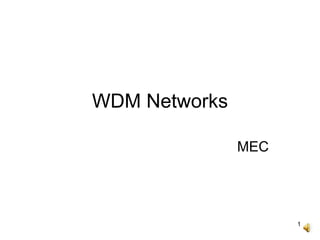
WDM Networks
- 2. 2 Contents • Introduction. • WDM Categories. • Device Classifications. • Performance Criteria. • Broadcast-and-select Network. • Wavelength Routing Network. • Virtual Topology. • Single-hop Network. • Multi-hop Network.
- 3. 3 Wavelength Division Multiplexing • Conceptually similar to Frequency Division Multiplexing. • Combines different carrier wavelengths onto a single fiber at one end and separates them at the other end. • Simultaneous transmission of optical signals over the same physical medium. • Each source has a different peak wavelength. • Common medium shared by different wavelengths. • Increase in information capacity of the system.
- 4. 4 Wavelength Division Multiplexing • A single optical source uses only a small part of available spectral transmission band of a fiber. • Simultaneous use of many spectral channels.
- 7. 7 Multiplexer Categories • Angularly dispersive devices. – prisms. - gratings. • Filter based devices. – multilayer thin film interference filters. - single mode integrated optical devices. • Passive WDM Devices. – wavelength selectivity fixed. • Active WDM Devices. – can be actively switched/tuned according to wavelength.
- 8. 8 Angularly Dispersive Devices Wavelengths can be combined or separated. Collimating Lens Focusing Lens Linear Dispersion Angular Dispersion
- 9. 9 Multi-thin Film Filter Reflector Transparent at λ2 and reflects λ1.
- 10. 10 Tunable Filter Different signals sent in individual frequency channels each of bandwidth B. A tunable filter of passband B selects the desired channel.
- 11. 11 Wavelength Tunable Filter IB Spectral Output variation altered by changing the path length through the crystal. Reversible Optical Path Length, use as MUX/DEMUX
- 12. 12 Performance Criteria • Insertion Loss: –Amount of power loss in fiber optic line due to addition of a WDM coupling device. - Losses occurring at the connection points of WDM element. - Intrinsic losses within multiplexing element.
- 13. 13 Performance Criteria • Channel Width: - Range of wavelength allocated to a particular source. - Channel widths of several tens of nanometers required for laser diodes. - LEDs have wider spectral output, 10-20 times larger channel widths required when compared to laser diodes.
- 14. 14 Performance Criteria • Cross Talk: - Amount of signal coupling from one channel to other. - Tolerable levels depend on the application. - A -30dB level tolerable in general, but -10dB not.
- 15. 15 WDM Networks • Optical fiber networks use wavelength division multiplexing (WDM) techniques. • Classified as broadcast-and-select networks or wavelength routing networks. • Broadcast-and-select network: - based on a star coupler. - broadcast to all nodes. - single-hop or multi-hop.
- 17. 17 Broadcast-and-Select Network • Optical transmission broadcast to all other nodes using fixed transmitters. • Tunable receiver at the destination node extracts desired signal from the entire group of signals. • All transmissions broadcast to all network nodes. • Most of the transmitted power depleted on the receivers which do not use it.
- 18. 18 Wavelength Routing Network • As the number of nodes increases, each station receives a small fraction of overall transmitted power. • Wavelength routing network used to avoid wastage of transmitted power. • Each network node provided with restricted connection(s) to the receiver(s). • Signal routed to specific destination through either a single node or using multiple nodes.
- 19. 19 Wavelength Routing Physical connection Wavelength assignments Virtual topology 3 wavelengths used
- 20. 20 Wavelength Routing • Uses three wavelengths (λ1, λ2 and λ3). • Any network node can transmit or receive a signal from another node within the network. • Wavelength implementation/path selection known as routing and wavelength assignment (RWA). • Classified into single-hop or multi-hop.
- 21. 21 Wavelength Routing • Node A can transmit to node B using wavelength λ1. • Node A can simultaneously receive from node B using wavelength λ2 only through node E. • No physical connection between nodes C and E.
- 22. 22 Virtual Topology • Virtual topology used to describe only the enabled wavelength paths. • Only wavelength signals identify interconnections between nodes. • No physical connection between nodes C and E. • Nodes can communicate via virtual connection set up using wavelengths λ1 and λ3.
- 23. 23 Single-hop Networks • Allow direct communication between any two nodes. • Data remains entirely in the optical domain. • No conversion to electrical domain till it reaches destination.
- 24. 24 Multi-hop Networks • Transmission may take place through intermediate nodes before reaching its destination. • Data can be switched electronically to the next possible node at each intermediate node, then retransmitted as optical signal. • Conversion process inefficient, but necessary if no common wavelength path between two nodes.
- 25. 25 Thank You